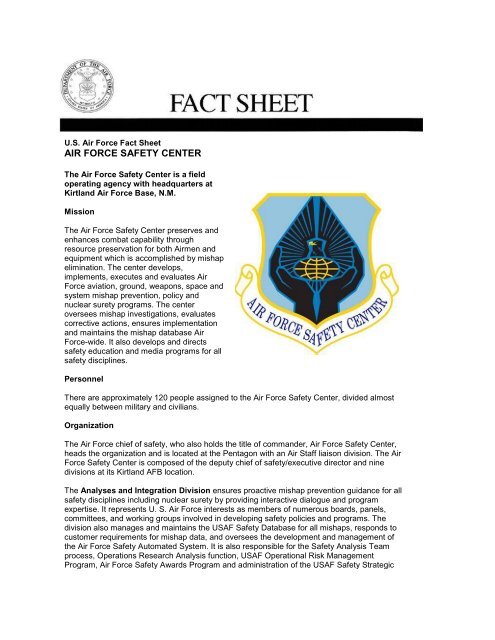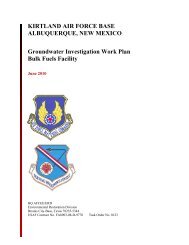AIR FORCE SAFETY CENTER - Kirtland Air Force Base
AIR FORCE SAFETY CENTER - Kirtland Air Force Base
AIR FORCE SAFETY CENTER - Kirtland Air Force Base
Create successful ePaper yourself
Turn your PDF publications into a flip-book with our unique Google optimized e-Paper software.
U.S. <strong>Air</strong> <strong>Force</strong> Fact Sheet<br />
<strong>AIR</strong> <strong>FORCE</strong> <strong>SAFETY</strong> <strong>CENTER</strong><br />
The <strong>Air</strong> <strong>Force</strong> Safety Center is a field<br />
operating agency with headquarters at<br />
<strong>Kirtland</strong> <strong>Air</strong> <strong>Force</strong> <strong>Base</strong>, N.M.<br />
Mission<br />
The <strong>Air</strong> <strong>Force</strong> Safety Center preserves and<br />
enhances combat capability through<br />
resource preservation for both <strong>Air</strong>men and<br />
equipment which is accomplished by mishap<br />
elimination. The center develops,<br />
implements, executes and evaluates <strong>Air</strong><br />
<strong>Force</strong> aviation, ground, weapons, space and<br />
system mishap prevention, policy and<br />
nuclear surety programs. The center<br />
oversees mishap investigations, evaluates<br />
corrective actions, ensures implementation<br />
and maintains the mishap database <strong>Air</strong><br />
<strong>Force</strong>-wide. It also develops and directs<br />
safety education and media programs for all<br />
safety disciplines.<br />
Personnel<br />
There are approximately 120 people assigned to the <strong>Air</strong> <strong>Force</strong> Safety Center, divided almost<br />
equally between military and civilians.<br />
Organization<br />
The <strong>Air</strong> <strong>Force</strong> chief of safety, who also holds the title of commander, <strong>Air</strong> <strong>Force</strong> Safety Center,<br />
heads the organization and is located at the Pentagon with an <strong>Air</strong> Staff liaison division. The <strong>Air</strong><br />
<strong>Force</strong> Safety Center is composed of the deputy chief of safety/executive director and nine<br />
divisions at its <strong>Kirtland</strong> AFB location.<br />
The Analyses and Integration Division ensures proactive mishap prevention guidance for all<br />
safety disciplines including nuclear surety by providing interactive dialogue and program<br />
expertise. It represents U. S. <strong>Air</strong> <strong>Force</strong> interests as members of numerous boards, panels,<br />
committees, and working groups involved in developing safety policies and programs. The<br />
division also manages and maintains the USAF Safety Database for all mishaps, responds to<br />
customer requirements for mishap data, and oversees the development and management of<br />
the <strong>Air</strong> <strong>Force</strong> Safety Automated System. It is also responsible for the Safety Analysis Team<br />
process, Operations Research Analysis function, USAF Operational Risk Management<br />
Program, <strong>Air</strong> <strong>Force</strong> Safety Awards Program and administration of the USAF Safety Strategic
Plan.<br />
The Aviation Safety Division consists of safety-trained professionals spanning the domain of<br />
human and autonomous flight. The division preserves warfighting capability by establishing<br />
U.S. <strong>Air</strong> <strong>Force</strong> aviation safety policy and promoting mishap prevention programs for all aviation<br />
assets. It oversees the aviation mishap investigative process, the collection and accuracy of<br />
flight safety data, and the disposition of risk-mitigating actions. It provides proactive and<br />
reactive engineering, human factors, life support, and operational analyses of flight safety<br />
issues. Additionally, the <strong>Air</strong>craft Information Program, the Hazardous <strong>Air</strong> Traffic Report<br />
Program, the Bird <strong>Air</strong>craft Strike Hazard Program, and the Mishap Analysis and Animation<br />
Facility are directed by the division.<br />
The Ground Safety Division manages the <strong>Air</strong> <strong>Force</strong> ground safety program including<br />
operational, occupational, sports and recreation, and traffic safety. It develops and oversees<br />
ground safety policy, programs and procedures to provide a safe work environment and<br />
enhance the safety of <strong>Air</strong> <strong>Force</strong> personnel during off duty to help maintain combat capability<br />
and readiness.<br />
The Space Safety Division is responsible for two diverse disciplines. The assured safe access<br />
to space and the safe management of emerging directed energy weapons, or DEW, systems.<br />
As the Department of Defense lead for space safety, the division is responsible for overseeing<br />
the safe development, operation and maintenance of <strong>Air</strong> <strong>Force</strong> space assets (including ground<br />
based systems). This includes coordination of space safety principles and policies amongst all<br />
national and international space-fairing entities. The division is also the DOD representative to<br />
the Inter-Agency Nuclear Safety Review Panel, advising the president on all space launches<br />
that carry nuclear material. In addition, the Space Safety Division is the DOD flagship for<br />
establishing operational guidelines for the safe management of the DEW systems, including<br />
lasers and high power microwaves. This division is responsible for weapons certification for<br />
new DEW systems, and chairs the AF Laser System Safety Review Board, which provides the<br />
safety approval for all <strong>Air</strong> <strong>Force</strong> operational lasers, and is a member of the DOD Radio<br />
Frequency Radiation Working Group.<br />
The Weapons Safety Division establishes and executes mishap prevention programs for all<br />
nuclear and conventional weapons systems. The division provides nuclear systems design<br />
certification, explosives safety standards development and siting reviews, weapons safety<br />
consultation, as well as system inspection, oversight, education, explosives hazard<br />
classifications and staff assistance in its areas of responsibility.<br />
The Safety Assessment Division facilitates mishap prevention through hazard identification<br />
and risk mitigation recommendations. The division coordinates Organizational Safety<br />
Assessments at the request of base-level commanders to identify organizational climate factors<br />
with safety implications. The division also manages the web-based AF Culture Assessment<br />
Safety Tool program offering operational, maintenance and support as well as ground culture<br />
safety surveys.<br />
The Media, Education and <strong>Force</strong> Development Division provides safety education and<br />
training to personnel, focusing on career and additional duty safety professionals, to enhance<br />
their knowledge and awareness to safely accomplish the mission and preserve vital national<br />
resources. Seven professional and various technical safety courses are taught in 45 sessions<br />
ranging from three days to 10 weeks, to more than 1,800 students annually. Division personnel<br />
also produce the following <strong>Air</strong> <strong>Force</strong> Safety magazines: Flying Safety, Road and Rec, and<br />
Weapons Journal; providing all <strong>Air</strong>men enhanced knowledge of recurring safety requirements<br />
through the proactive marketing of safety events, issues, and concerns through newsletters,<br />
videos, and commercials.
The Resource Management, Manpower and Career Programs Division establishes policy<br />
and manages <strong>Air</strong> <strong>Force</strong> safety civilian and enlisted career fields. It is the functional manager for<br />
the <strong>Air</strong> <strong>Force</strong> safety manpower standard and variances. The division also establishes policy<br />
and manages AFSC military and civilian personnel actions. In addition, it is responsible for the<br />
center's manpower requirements and budget management.<br />
The Issues Division, , a detachment in the Pentagon, provides a direct interface with<br />
members of the <strong>Air</strong> Staff. It facilitates responses to questions on safety related issues raised by<br />
the chief of staff and members of the staff. The division also represents the chief of safety at <strong>Air</strong><br />
Staff meetings and boards. .<br />
The Office of the Staff Judge Advocate provides legal advice and general counsel on all<br />
aspects of <strong>Air</strong> <strong>Force</strong> mishap prevention programs and safety investigations. It also provides<br />
effective coordination on legal and safety issues with the DOD, other federal agencies, and<br />
international safety programs. The office maintains the AFSC Records Library, allowing<br />
efficient and timely retrieval of safety investigation reports for review and analysis. In addition, it<br />
responds to requests for safety information under the Freedom of Information Act,<br />
Congressional requests and other functional requests.<br />
History<br />
After the <strong>Air</strong> <strong>Force</strong> became a separate department, the <strong>Air</strong> <strong>Force</strong> chief of staff designated the<br />
Office of the Inspector General to oversee all inspection and safety functions. These functions<br />
were consolidated in an Inspector General group at Norton AFB, Calif., in the 1950s.<br />
On Dec. 31, 1971, the <strong>Air</strong> <strong>Force</strong> Inspection and Safety Center was activated, replacing the<br />
1002nd IG Group. The center was divided into the <strong>Air</strong> <strong>Force</strong> Inspection Agency and the <strong>Air</strong><br />
<strong>Force</strong> Safety Agency in August 1991. Reorganization of the <strong>Air</strong> Staff in 1992 created the <strong>Air</strong><br />
<strong>Force</strong> chief of safety position reporting directly to the <strong>Air</strong> <strong>Force</strong> chief of staff. The chief of safety<br />
became dual-hatted as the commander of the <strong>Air</strong> <strong>Force</strong> Safety Agency. In July 1993, the<br />
agency moved to <strong>Kirtland</strong> AFB, N.M. due to the closure of Norton AFB<br />
Following The Blue Ribbon Panel on Aviation Safety in 1995, the <strong>Air</strong> <strong>Force</strong> Safety Center was<br />
activated on Jan. 1, 1996, when the <strong>Air</strong> <strong>Force</strong> chief of safety and support staff moved from<br />
Washington, D.C., to consolidate all safety functions at <strong>Kirtland</strong> AFB. The chief of<br />
safety position was changed from a brigadier general to a major general.<br />
The deputy chief of safety/executive director position was created in October, 2003, to oversee<br />
the daily functions of the center. The chief of safety and support staff moved back to the<br />
Pentagon in April, 2004.<br />
Point of Contact<br />
<strong>Air</strong> <strong>Force</strong> Safety Center, Office of the Commander; 9700 G Avenue SE; <strong>Kirtland</strong> AFB, NM<br />
87117-5670; DSN 246-0550 or (505) 846-0550.
















